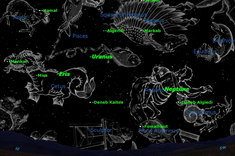Cancer, which is Latin for crab , is the dimmest of the 13 constellations of the Zodiac, having only two stars above the fourth magnitude.
The small faint constellation Cancer is rich in open clusters and double stars.
Credit: Starry Night Software
Locating Cancer the Crab
Cancer lies between Leo, the lion, and Gemini, the twins. It is almost impossible to see Cancer as a crab with the naked eye or even binoculars. It looks more like a faint, upside-down Y.
Cancer is visible in the Northern Hemisphere in the early spring. It can be seen in the Southern Hemisphere during autumn. The Cancer constellation occupies an area of 506 square degrees.
- Right ascension: 9 hours
- Declination: 20 degrees
- Best seen between latitudes 90 degrees and minus 60degrees
- Visibility is best during March at 9 p.m.
Cancer contains two Messier objects, a set of astronomical objects first in 1771 by French astronomer Charles Messier in 1771. Cancer’s most famous Messier object is M44, also known as the Beehive Cluster, which is a small star cluster that resembles a swarm of bees. M44 contains about 50 stars, the brightest of which are of the sixth magnitude. ε Cnc is the brightest member at magnitude 6.3. Praesepe is also one of the larger visible open clusters with an area of 1.5 square degrees, or three times the size of the full moon.
The constellation’s other Messier object, M67, is another open star cluster.
β Cnc is the brightest star in Cancer at magnitude 3.5. It is an orange-hued giant star about 290 light-years from Earth.
The star α Cnc (Acubens), which means “the claw,” is a double star with a primary of magnitude 4.3, 173 light-years from Earth.
Other notable stars include the γ Cnc (Asellus Borealis), the “northern donkey,” a white-hued star (158 light-years), and δ Cnc (Asellus Australis), “southern donkey,” an orange-hued giant star (136 light-years).
Exoplanets
Perhaps the most famous exoplanet in the constellation is 55 Cancri e, a super-Earth that was (for a time) identified as a “diamond world .” The original observations in 2010 suggested that the host star had more carbon than oxygen in its interior. A subsequent 2012 study then modeled 55 Cancri e’s mass and radius, based on the composition of its planet star, and suggested this planet had a graphite surface overlying a massive layer of diamond underneath.
However, a follow-up study in 2013 suggested that there is far less carbon in the planet than originally envisioned — so “diamond” may be a misnomer. The host star of the planet only has about 25 percent more oxygen than carbon, that research team suggested. (This came from a different interpretation of the chemical composition of the star as expressed in the star’s spectrum.)
Meanwhile, the Spitzer Space Telescope was used to monitor the heat emissions from 55 Cancri e. Early 2013 results suggested that the planet could be very warm and wet , while 2016 follow-ups revealed that the planet is scorching hot and could be oozing lava .
Results released from Spitzer in 2016 showed that daytime temperatures on 55 Cancri e can reach as high as 4,000 degrees Fahrenheit (2,427 degrees Celsius) and about half as much at night — 2,025 F (1,107 C.) The nature of the surface is still unclear, but researchers did see a hotspot about midway between the day and night sides that is still poorly explained.

0 of 10 questions complete
Mythology
The constellation of Cancer represents the giant crab that attacked Hercules during the second of the 12 labors he performed as penance for killing his family. It was sent by the jealous goddess Hera to thwart Hercules as he battled the water serpent Hydra, but he killed it with his club.
In astrology, which is not a science , Cancer is the fourth sign of the Zodiac and represents those born between June 20 and July 22. It is considered a water sign and is one of the four cardinal signs, which are signs that indicate a change of season when the sun makes its annual passage into them.
Additional reporting by Elizabeth Howell, Space.com Contributor.
Related:

Comments are closed.